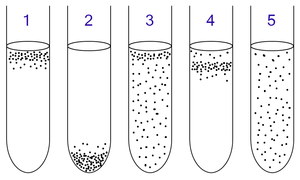This is an old revision of this page, as edited by 209.49.166.155 (talk) at 18:55, 26 November 2012. The present address (URL) is a permanent link to this revision, which may differ significantly from the current revision.
Revision as of 18:55, 26 November 2012 by 209.49.166.155 (talk)(diff) ← Previous revision | Latest revision (diff) | Newer revision → (diff)18:55, 26 November 2012 (UTC)18:55, 26 November 2012 (UTC)18:55, 26 November 2012 (UTC)18:55, 26 November 2012 (UTC)18:55, 26 November 2012 (UTC)18:55, 26 November 2012 (UTC)18:55, 26 November 2012 (UTC)18:55, 26 November 2012 (UTC)≤←

1: Obligate aerobic bacteria gather at the top of the test tube in order to absorb maximal amount of oxygen.
2: Obligate anaerobic bacteria gather at the bottom to avoid oxygen.
3: Facultative bacteria gather mostly at the top, since aerobic respiration is the most beneficial one; but as lack of oxygen does not hurt them, they can be found all along the test tube.
4: Microaerophiles gather at the upper part of the test tube but not at the top. They require oxygen but at a low concentration.
5: Aerotolerant bacteria are not affected at all by oxygen, and they are evenly spread along the test tube.
Diversity
Yeast is an example of a facultative anaerobe, which can develop in the presence of oxygen but does not require it. Individual human cells are also facultative anaerobes: they switch to lactic acid fermentation if oxygen is not available. However, for the whole organism this cannot be sustained for long, and humans are therefore obligate aerobes.
References
See also
- Aerobic digestion
- Anaerobic digestion
- Facultative anaerobic organism
- Fermentation (biochemistry)
- Microaerophile
| Microbiology: Bacteria | |||||||
|---|---|---|---|---|---|---|---|
| Medical microbiology | |||||||
| Biochemistry and ecology |
| ||||||
| Shape | |||||||
| Structure |
| ||||||
| Taxonomy and evolution | |||||||
Categories: